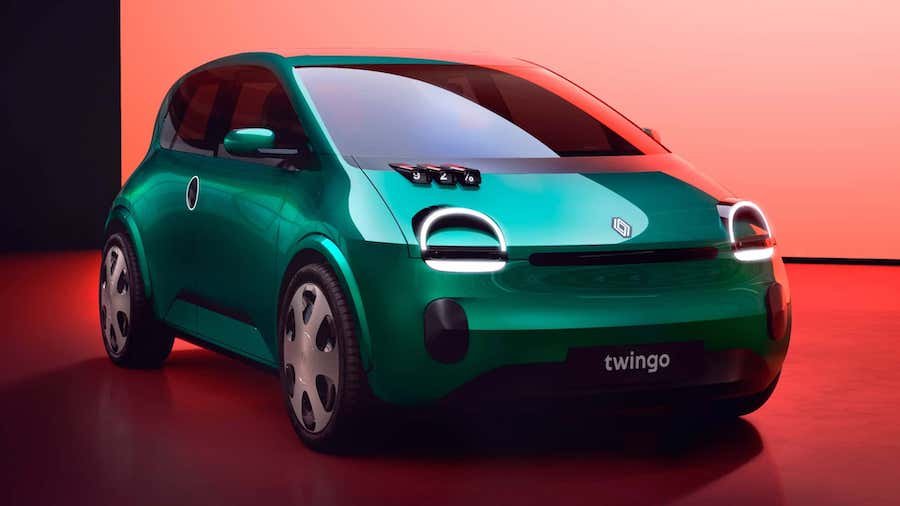Renault 5 design revealed ahead of February debut

The design of the production version of the highly anticipated Renault 5 supermini has been revealed a few months early.
Renault has confirmed it will show the electric 5 at the Geneva motor show on 26 February 2024, but new designs filed to the World Intellectual Property Organisation (WIPO) give an early look - revealing that it will stay remarkable close to the acclaimed 2021 concept car.
The reborn 5 has been changed only very little in its evolution from sketchpad to showroom, as implied by recent teaser images released by Renault.
The headlight surrounds, for example, appear to be slightly rounder, and the projectors are now more conventionally shaped LED blocks.
A charge indicator features on the bonnet – similar to that on the new Renault Twingo concept – with a light-up '5' motif that is used to display the battery charge level.
At the rear end, the gap between the upper and lower segments of the brake light is wider than before. The light bar that spanned the full width of the rear end has been replaced with a solid-black trim piece.
Alongside the release of teaser images, the brand also confirmed that the new 5's 52kWh battery yields a range of 248 miles, according to WLTP tests.
The 5 is being developed to be the most fun small electric car to drive, according to Renault boss Luca de Meo and his fellow company executives. "The Renault 5 is the car that everybody wants. It's a legend that inspired all generations, and everyone is looking forward to it,” de Meo said at a recent event.
“The final car will be revealed in February at Geneva. I've already test-driven it, and I can't wait to open pre-orders."
The car's Ampr Small platform (formerly named CMF-B-EV), which is also set to underpin the 2026 Renault 4, includes a suite of technologies aimed at providing enjoyable handling.
Chief among these is a multi-link rear axle, claimed by Renault to be the only one used by a B-segment electric car. Multi-link suspension typically provides a better balance between ride and handling than the torsion beams used by the Renault Zoe.
This is because it provides engineers with finer control over the two parameters separately from each other, minimising the compromises inherent to less complex non-independent suspension.
Asked to clarify what cars the 5’s dynamics are being benchmarked against and how “fun” is being defined, Renault executives wouldn't comment on the competition. However, Jean-Sébastien Blazy, vice-president for vehicle performance, told Autocar: “The R5 will be totally comparable in terms of vehicle dynamics [with] the Mégane E-Tech.”
He also said: “Thanks to the rear axle, we had the opportunity to have this multi-link and to put a lot of understeering behaviour on the rear axle. It’s thanks to that you have a very good stability of the car, because safety is key for sure.
“But with this rear axle, you can have a very dynamic steering without compromise on safety. So, this is our secret in order to give our car very good agility [and] very good steering response and to ensure the stability of the car in extreme manoeuvres, like avoiding a kid or an event or on the road.”
Blazy also emphasised the role to be played by the platform’s all-new brakes, which are being developed to more smoothly blend the hydraulic and regenerative systems. “[Drivers] will not feel the recovery of energy in our future car through the brake pedal,” he said.
Minimising weight will also be key to the 5’s claimed dynamic prowess. Its battery, for example, uses a new layout with cells split into four square ‘big modules’. This is said to improve energy density and therefore reduce weight by 15kg compared with the Zoe’s 52kWh pack.
The 5 will also receive new motors that omit magnets and integrate the charger, power converter and auxiliary power-management box, cutting a further 20kg compared with the Zoe.
Renault has already confirmed that this motor will produce 134bhp and that it will be produced at the firm’s historic Cléon factory, which currently produces electric powertrains for the Mégane.
Although the 5 is claimed to be a technological leader in its segment compared with current alternatives, Renault is aiming for the model to be priced below its competitors – including the outgoing Zoe.
Key to this in the 5 will be the reuse of 70% of the components from the ICE variant of the CMF-B platform, which underpins the Renault Captur, Renault Clio, Nissan Juke and more.
The AmpR Small platform will eventually spawn a “complete family” of cars, according to Renault B-segment EV director Jérémie Coiffier.
Platform manager Gilles Godinot said: “It's really flexible in terms of track and wheelbase, and overhang of course, but mostly the track and wheelbase are really flexible.”
The new 5 concept was first revealed at the announcement of the Renaulution plan devised by Renault Group CEO Luca de Meo in 2021. He hailed it as a key part of Renault’s push for 30% of its sales to be of EVs by 2025.
The model takes its inspiration from the original 5, which was produced over two generations between 1972 and 1996, with references including the headlights and square daytime running lights.
De Meo, who during his time at Fiat was key in reviving the Fiat 500, said: “I know from experience that reinventing a cult products lights a fire under the whole brand. This is a cult vehicle at a price many can afford. And this is only the beginning for the whole Renault brand.”
Related News
